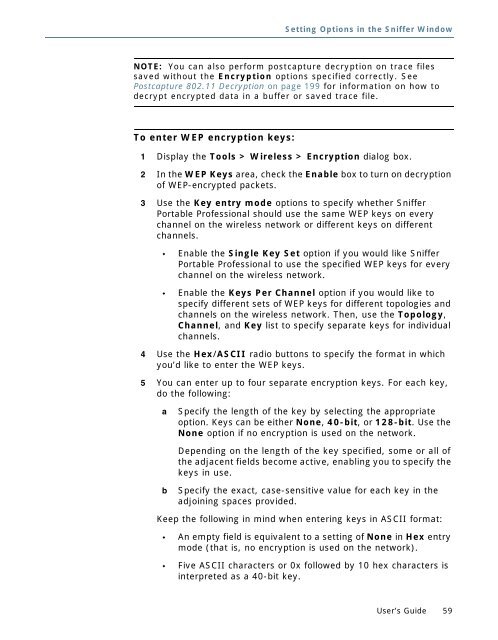Sniffer® Portable Professional User's Guide - NetScout
Sniffer® Portable Professional User's Guide - NetScout
Sniffer® Portable Professional User's Guide - NetScout
You also want an ePaper? Increase the reach of your titles
YUMPU automatically turns print PDFs into web optimized ePapers that Google loves.
Setting Options in the Sniffer Window<br />
NOTE: You can also perform postcapture decryption on trace files<br />
saved without the Encryption options specified correctly. See<br />
Postcapture 802.11 Decryption on page 199 for information on how to<br />
decrypt encrypted data in a buffer or saved trace file.<br />
To enter WEP encryption keys:<br />
1 Display the Tools > Wireless > Encryption dialog box.<br />
2 In the WEP Keys area, check the Enable box to turn on decryption<br />
of WEP-encrypted packets.<br />
3 Use the Key entry mode options to specify whether Sniffer<br />
<strong>Portable</strong> <strong>Professional</strong> should use the same WEP keys on every<br />
channel on the wireless network or different keys on different<br />
channels.<br />
Enable the Single Key Set option if you would like Sniffer<br />
<strong>Portable</strong> <strong>Professional</strong> to use the specified WEP keys for every<br />
channel on the wireless network.<br />
Enable the Keys Per Channel option if you would like to<br />
specify different sets of WEP keys for different topologies and<br />
channels on the wireless network. Then, use the Topology,<br />
Channel, and Key list to specify separate keys for individual<br />
channels.<br />
4 Use the Hex/ASCII radio buttons to specify the format in which<br />
you’d like to enter the WEP keys.<br />
5 You can enter up to four separate encryption keys. For each key,<br />
do the following:<br />
a Specify the length of the key by selecting the appropriate<br />
option. Keys can be either None, 40-bit, or 128-bit. Use the<br />
None option if no encryption is used on the network.<br />
Depending on the length of the key specified, some or all of<br />
the adjacent fields become active, enabling you to specify the<br />
keys in use.<br />
b Specify the exact, case-sensitive value for each key in the<br />
adjoining spaces provided.<br />
Keep the following in mind when entering keys in ASCII format:<br />
An empty field is equivalent to a setting of None in Hex entry<br />
mode (that is, no encryption is used on the network).<br />
Five ASCII characters or 0x followed by 10 hex characters is<br />
interpreted as a 40-bit key.<br />
User’s <strong>Guide</strong> 59

















